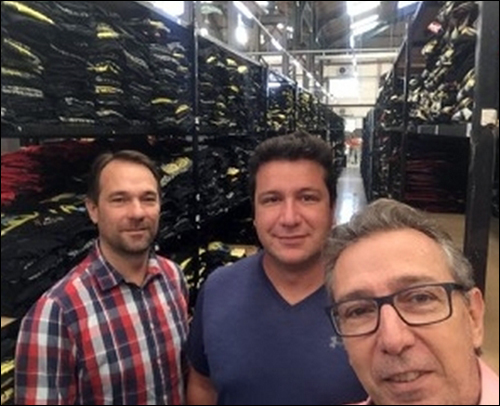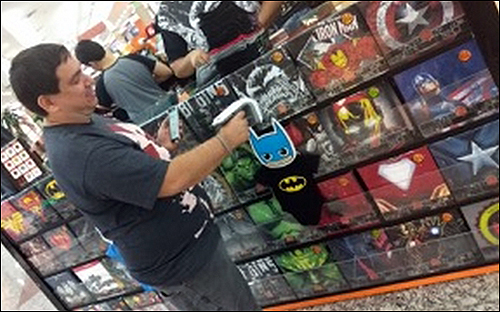Jun 19, 2018With more than 200,000 items marketed every month at 330 points of sale throughout Brazil—including at kiosks in malls and franchised T-shirt stores selling more than 50 national and international brands, such as Disney, Warner Bros., 20th Century Fox, Turma da Mônica, Universal and Lucasfilm—Piticas has invested in an RFID project using technology already implanted at 40 of its locations. As a result, the company has been able to reduce the amount of time required for inventory counts from five hours down to only six minutes.
Each store employs the RFID solution with Presence Store Point of Sale software and at least one Zebra Technologies RFD8500 portable reader. A smartphone is also required for Bluetooth data collection and information.
The tags used are iTag RFID smart labels, equipped with Impinj inlays, and glued to the paper labels of the T-shirts (they will soon be sewn on separately). The project started to inventory the stores and the factory, located in Guarulhos, which has 300,000 pieces of finishing stock. The system is already being planned for other areas as well.
Prior to the RFID system's deployment, most of the processes were manual. From the point of production to the separation of orders for shipment, everything was handled manually, using bar codes. Thus, RFID was implemented in the manufacturing processes of production control, order separation and shipment. In stores, the company began using the technology for the movement of goods and inventory counts.
The first favorable point of change at the factory was in regard to the quality of information. Processes were double-checked by bar codes and RFID during deployment, and errors were discovered that previously had gone unnoticed with manual readings. Another positive factor was a reduction in costs regarding the separation of orders, with a decrease in the amount of time required to execute the activity.
At stores, the control of goods became fully automated and managed via RFID. The RFID deployment follows GS1's standard for EPC UHF passive RFID technology. "Standardization is important since there is the feasibility of placing products beyond the borders of the network itself," says Felipe Rossetti, Piticas's director.
Readers are installed in two completely different environments. In the factory, there are reading portals in the passages between the various productive sectors. An insulated box was installed for cart entry with separate orders, for the purpose of invoice generation. "We have a reading trolley used in conjunction with manual readers for inventory of finished products," Rossetti says.
In-store RFID readings are made using portable inventory-count readers and Identix rPad UHF RFID desktop devices, which have an integrated circular-polarization antenna, reducing the cost of hardware acquisition and facilitates deployment. Besides Zebra readers, interrogators from Acura were also implemented. In total, there are 12 readers portals and eight inventory-cart readers, with a handheld RFID device at each store and, as an option, a desktop player.

"We are using adhesive tags provided by iTag, with Impinj's inlays, affixed to the labels of the goods," explains Paulo Palmério, Presence's CEO. The challenge of plant implantation, according to Palmério, was to develop adequate insulation and adjustment of readings depending on the quantity of products and interferences in the place. The density of goods is very large on shelves, which made it difficult to read the inventories.
"The store environment was no less challenging," Palmério says. "Normally, there are 2,300 pieces in a 4-meter-by-3-meter kiosk. The very large commodity density and the presence of small metal artifacts in the store environment, and even in the tags used previously, had to be revised to ensure the quality of reading in the process."
At Piticas, as the operational area addresses the IT area, the benefits of RFID could easily be seen, according to the company. Piticas is a network of stores, primarily kiosks spanning approximately 12 square meters, in which there is a stock of 2,300 items with a diversity of 1,300 stock-keeping units (SKUs). "This brings us to about 1.8 pieces per SKU," Rossetti says. "Thus, the correct determination of the number of parts, as well as quick replacement, avoids sales losses."
The use of RFID has ensured operational quality in inventory movements and, more importantly, the feasibility of carrying out periodic inventory counts at a frequency previously not feasible. "An inventory that was done in five hours started running in six minutes, which makes it possible to run it several times a week," Rossetti explains. Loss control was thus minimized, and reliability of stock allowed for more efficient replacement processes, since inventories are reported online to the matrix.
The project is already deployed in the factory, the firm reports, and is expected to be extended to control volumes, shipping and transportation as well. "We will also be implementing control of Electronic Product Code (EPC) movement logs from the production process, distribution, in-store sales and exchange returns," Palmério states. "After the stores, we will expand RFID to all business units, which is expected to be finalized by December 2018."
The RFID project was fully developed and integrated with Presence's enterprise resource planning (ERP) system, known as Presence Domain. ITag's middleware connectivity interfaces were developed in the ERP, as well as the processes for the integrated, efficient use of RFID. For inventory counts, specific applications have been developed that run on cell phones or desktop devices, allowing for proper mobility. In the store environment, inventory is integrated with Presence POS, Presence Store or the Presence Count mobile and tablet app.
"Experience has shown that the project has exceeded expectations," Rossetti reports. The best way to measure this, he notes, is through user experience. "At the beginning of the project, we anticipated the shared use of a shared reader for every three stores, because the reader is the most expensive item for the franchisee. The benefit of loss control and prevention has paid the cost of the reader."
The middleware is used exclusively in the factory environment and was developed by iTag. Integrated with the Presence Domain ERP in the store environment, a Presence Count mobile application was developed, which has the middleware layer embedded. The program and all integrations were fully developed by Presence.
Piticas has an innovation-driven identity and seeks technology solutions to optimize management and improve processes. The use of RFID was extremely positive, the company reports, and paved the way for other technology projects, by showing that the investments involved should not be a constraint when financial results outweigh costs.


